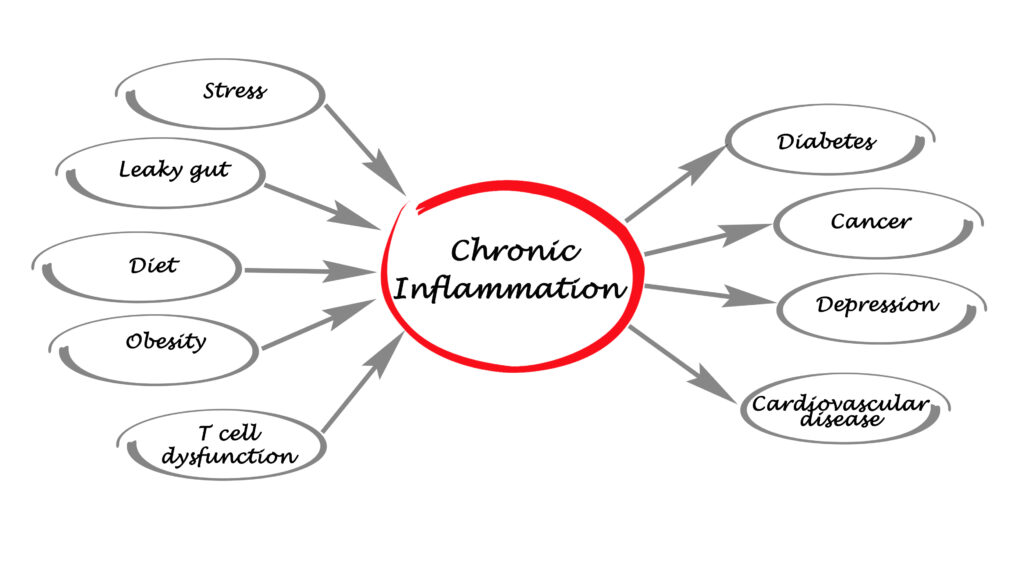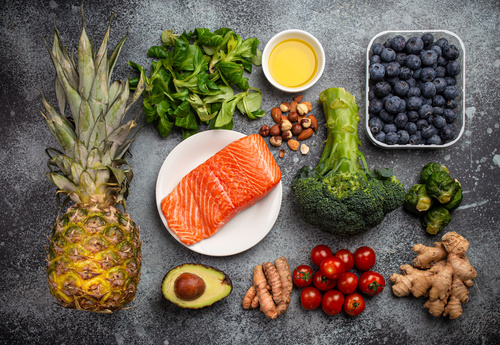You may remember having a cut, sprain, or a sore throat. The area feels painful and hot, and looks red and swollen. These are telltale signs of inflammation. Inflammation is a natural and essential process that your body uses to defend itself from infections and heal injured cells and tissues.
Inflammation is sometimes compared to a fire. It produces specific biochemicals that can destroy invaders like bacteria and viruses, increase blood flow to areas that need it, and clean up debris. It can be a good thing. But, sometimes it’s possible to have too much of a good thing.
Before we talk about the power that certain dietary and lifestyle habits can have on inflammation, let’s sort out the two different types.
Types of inflammation (acute vs. chronic)
There are two kinds of inflammation: acute and chronic. Acute inflammation is short-lived. It’s like a flaming fire that produces the painful, red, hot, swollen symptoms described above. When inflammation is acute it’s usually at high levels in a small localized area in response to an infection or some kind of damage to the body. It’s necessary for proper healing and injury repair.
When your cells detect an infection or damage they send out warning signals to call over your immune system to help out. Your immune system sends over many types of white blood cells to help fight off invading bacteria and pathogens, and clean up damage so you can heal.
Symptoms of acute inflammation may need short-term treatment such as pain relievers or cold compresses. More serious symptoms like fever, severe pain, or shortness of breath may need medical attention. In general, it goes away after the damage is healed, often within days or even hours. Acute inflammation is the “good” kind of inflammation because it does an essential job and then quiets itself down.
Chronic inflammation is different. It’s more of the slow-burning and smoldering type of fire. This type of inflammation can exist throughout your whole body at lower levels. This means that the symptoms aren’t localized to one particular area that needs it. Instead, they can appear gradually, and can last much longer—months or even years. This is the “bad” kind of inflammation.

Chronic inflammation is often invisible without immediate or serious symptoms, but over the long-term it’s been linked to many chronic diseases such as autoimmune diseases, cancer, diabetes, chronic pain, acne, eczema or psoriasis, heart disease, Alzheimer’s, anxiety and depression.
What are symptoms of inflammation?
Visible signs of inflammation can also arise, but are often ignored or accepted as the new norm for people. However it’s so important to tune in and see if any of these “smoke signals” are present in your body and address them!
- Feeling tired all the time or swings in energy throughout the day
- Brain fog
- Bloating or other digestive issues
- Stubborn belly fat
- Frequent headaches
- Breakouts and skin issues
- Frequent join pain or frequent headaches
How does chronic inflammation begin?
It may start acutely—from an infection or injury—and then instead of shutting off, it becomes persistent. Chronic low-grade inflammation can also occur with exposure to chemicals (e.g., tobacco) or radiation, consuming an unhealthy diet or too much alcohol, not being very physically active, feeling stressed or socially isolated, digestive issues like leaky gut, and having excess weight.
Now that we see that inflammation underlies so many of our medical conditions, here’s what to do to put out those slow-burning, smoldering fires.
How can I reduce inflammation in my body?
Studies show that reducing inflammation can reduce the risk of several of the above conditions, including heart disease and cancer. There are medications used to help lower inflammation to treat some of these diseases such as corticosteroids, immunosuppressants, and biologics. However, there are also several lifestyle changes—including a healthy diet—that can be very helpful to prevent and scale down inflammation to reduce its many damaging effects on the body.
“For chronic low-grade inflammation not caused by a defined illness, lifestyle changes are the mainstay of both prevention and treatment,” says Harvard Health. The good news is that anti-inflammatory foods help you stay healthy and reduce your risk of many diseases. In fact, it’s estimated that 60 percent of chronic diseases could be prevented with a healthy diet. Here’s how.
Enjoy an anti-inflammatory diet
● Increase your intake of fruits and vegetables, wild caught fish, pasture-raised eggs and chicken, grass fed meat, legumes (beans, lentils as tolerated), and healthy fats (olive and avocado oil, avocados, coconut and coconut oil, nuts and seeds, nut butters)
● Pay particular attention to foods high in antioxidant polyphenols, including colorful plants such as berries, cherries, plums, red grapes, avocados, onions, carrots, beets, turmeric, green tea, and dark green leafy vegetables like spinach and kale
● Omega-3 fats can help to reduce pain and clear up inflammation and are found in salmon, trout, mackerel, soy, walnuts, and flax.
● Reduce inflammatory fats such as fried foods, hydrogenated oils or trans fat (such as shortening), and soybean and vegetable oils found in processed packaged foods.
● High fiber foods (whole grains such as oats and quinoa, nuts and seeds, vegetables, fruits, legumes) encourage friendly gut microbes to help reduce inflammation
● Cut out added sugar and white flour. These spike insulin and blood sugars which causes inflammation in the body. Instead choose whole food carbohydrates such as sweet potatoes, berries, apples, pears, beans and lentils, winter squash, plain and dairy free yogurt, and non-starchy vegetables like salad greens, broccoli and cauliflower.

Be physically active
● Regular exercise reduces inflammation over the long-term, so try to get at least 150 minutes of moderate-intensity aerobic exercise (brisk walking) per week; about 20-30 minutes per day
● To this add two or more strength training sessions (using weights or resistance bands) each week
Get enough restful sleep
● Disrupted sleep has recently been linked to increased inflammation and atherosclerosis (the buildup of plaque in the vessels that’s linked with heart disease), so aim for 7-9 hours of restful sleep every night to help the body heal and repair
● Tips for better sleep: try to maintain a regular sleep-wake schedule every day, get exposure to natural daylight earlier in the day, avoid caffeine later in the day, cut out screens an hour before bedtime, and create a relaxing nighttime routine
Manage your stress
● Chronic stress can wreck your hormones, which over time can lead to insulin resistance, poor digestion, and inflammation.
● Engage in relaxing, stress-reducing activities such as mindfulness-based stress reduction (MBSR), deep breathing, meditation, yoga, or tai chi. Journaling, taking an Epsom salt bath, going for a walk, or a hike in nature can also help.
Blood tests for inflammation
● Get your cholesterol and blood lipids tested because high amounts of triglycerides and low “good” HDL cholesterol is linked to inflammation and negatively affects your vessels.
● Have your fasting insulin, fasting glucose and hemoglobin A1C checked to rule out insulin resistance, which is a root cause of inflammation.
● You can request a blood test to measure levels of CRP (C-reactive protein) which is a marker of inflammation (this test is also used to check your risk of developing heart disease)
● If your gums bleed when you brush or floss, this may be a sign of gum inflammation (gingivitis), so ramp up your oral hygiene and see your dentist
Final thoughts
Chronic, long-term, low-level inflammation is linked with many health issues. The first approach to preventing and improving this is through food and lifestyle changes. Start by focusing on adding colorful fruits and vegetables, nuts, seeds, and fish to your diet. Then layer in lifestyle upgrades like physical activity, restful sleep, and stress management.
These changes can be integrated into your day-to-day practices. First try replacing sugar and processed foods with whole food options. This could look like substituting your morning bagel with a nourish bowl with sweet potatoes, eggs, and avocado, or replacing sweetened beverages with water or flavored sparkling water. For inspiration, follow me on IG @anti_inflammation.dietitian or on Facebook @sustainedroots.
If you’re looking for meal inspiration, check out my new recipe guide for 20 low glycemic breakfast ideas here.
Want to learn how you can beat inflammation with simple and delicious foods? Need a plan and delicious recipes to get more antioxidants into your diet? Are you looking for ways to incorporate more anti-inflammatory foods into your day?
Join me for my free upcoming workshop on Fight Inflammation: The Power of Food or book an appointment with me to see if my program/service can help you. Register here!
References
Harvard Health. (2018, November 7). Foods that fight inflammation. Retrieved from
Harvard Magazine. (2019 May-June). Could inflammation be the cause of myriad chronic conditions? Retrieved from https://harvardmagazine.com/2019/05/inflammation-disease-diet
Harvard Health. (2020, April). Understanding acute and chronic inflammation. Retrieved from
Harvard Health. (2020, May). Quick-start guide to an anti-inflammation diet. Retrieved from
Harvard Health. (2020, June). All about inflammation. Retrieved from
Mayo Clinic. (2017, November 21). C-reactive protein test. Retrieved from https://www.mayoclinic.org/tests-procedures/c-reactive-protein-test/about/pac-20385228
Mayo Clinic. (2018, May 25). Home remedies: How a healthy diet can help manage pain. Retrieved from https://newsnetwork.mayoclinic.org/discussion/home-remedies-how-a-healthy-diet-can-help-manage-pain/
Mayo Clinic. (2019, August 13). How to use food to help your body fight inflammation. Retrieved from https://www.mayoclinic.org/healthy-lifestyle/nutrition-and-healthy-eating/in-depth/how-to-use-food-to-help-your-body-fight-inflammation/art-20457586
Medscape. (n.d.). Inflammation, Cardiovascular Disease, and Cancer. Retrieved from https://www.medscape.com/viewarticle/923743
National Institute of Environmental Health Sciences. (2020, April 4). Inflammation. Retrieved from https://www.niehs.nih.gov/health/topics/conditions/inflammation/index.cfm
Neuroscience News. (2020, March 5). Social isolation could cause physical inflammation. Retrieved from https://neurosciencenews.com/social-isolation-inflammation-15864/
University of California Berkeley News. (2020, June 4). Fitful nightly sleep linked to chronic inflammation, hardened arteries. Retrieved from https://news.berkeley.edu/2020/06/04/fitful-nightly-sleep-linked-to-chronic-inflammation-hardened-arteries/
University of Wisconsin-Madison School of Medicine and Public Health. (2018). The anti-inflammatory lifestyle. Retrieved from https://www.fammed.wisc.edu/files/webfm-uploads/documents/outreach/im/handout_ai_diet_patient.pdf
